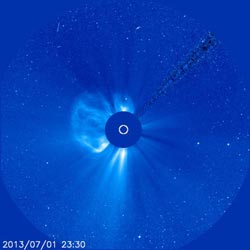Coronal Mass Ejection Headed Toward Mercury and Venus

On July 1, 2013, the sun erupted with a coronal mass ejection, or CME – shown here as the lighter-colored gas moving off to the left -- which soared off in the direction of Venus and Mars. This image was captured by the joint ESA/NASA Solar and Heliospheric Observatory. <br>Image Credit: ESA and NASA/SOHO<br>
Experimental NASA research models based on NASA’s Solar Terrestrial Relations Observatory show that the CME was not Earth-directed and it left the sun at around 570 miles per second.
The CME may, however, pass by NASA’s Messenger, Spitzer and STEREO-B satellites, and their mission operators have been notified.
There is only very slight particle radiation associated with this event, which is what would normally concern operators of interplanetary spacecraft, because the particles can trip computer electronics aboard interplanetary spacecraft.
If warranted, operators can put spacecraft into safe mode to protect the instruments from the solar material.
NOAA's Space Weather Prediction Center (http://swpc.noaa.gov) is the U.S. government's official source for space weather forecasts, alerts, watches and warnings.
Updates will be provided as needed.
Karen C. Fox
NASA's Goddard Space Flight Center, Greenbelt, Md.
Media Contact
All latest news from the category: Physics and Astronomy
This area deals with the fundamental laws and building blocks of nature and how they interact, the properties and the behavior of matter, and research into space and time and their structures.
innovations-report provides in-depth reports and articles on subjects such as astrophysics, laser technologies, nuclear, quantum, particle and solid-state physics, nanotechnologies, planetary research and findings (Mars, Venus) and developments related to the Hubble Telescope.
Newest articles

Airborne single-photon lidar system achieves high-resolution 3D imaging
Compact, low-power system opens doors for photon-efficient drone and satellite-based environmental monitoring and mapping. Researchers have developed a compact and lightweight single-photon airborne lidar system that can acquire high-resolution 3D…

Simplified diagnosis of rare eye diseases
Uveitis experts provide an overview of an underestimated imaging technique. Uveitis is a rare inflammatory eye disease. Posterior and panuveitis in particular are associated with a poor prognosis and a…

Targeted use of enfortumab vedotin for the treatment of advanced urothelial carcinoma
New study identifies NECTIN4 amplification as a promising biomarker – Under the leadership of PD Dr. Niklas Klümper, Assistant Physician at the Department of Urology at the University Hospital Bonn…





















